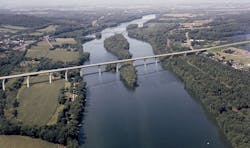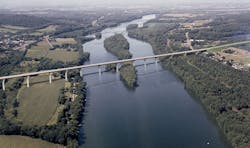Region Report: The Rust Belt
OHIO:
A fantastic fury
Bill Wilson, Editorial Director
Located in northwest Ohio, the city of Toledo has just as many University of Michigan devotees as it does Ohio State University fans.
The area is used to times of fury, but non-stop for four years straight? Hard to imagine, but it is all about over now . . . the streets are much improved.
The Ohio Department of Transportation (ODOT) was able to merge 25 years’ worth of Toledo road and bridge work into just four, thanks to innovative financing, leveraging tolls from the Ohio Turnpike to purchase bonds for major projects across the northern portion of the state.
“Toledo has benefitted greatly from a ton of investment,” Matt Bruning, press secretary for ODOT’s Central Region, told Roads & Bridges. “Now that we are coming to an end of that four years of fury, people are starting to see the benefits and are quite happy.”
It has taken quite a bit of innovation, but ODOT has been able to thrive while other state DOTs wallow in budget hardship. According to Bruning, when 2018 comes to a close it will mark a little more than $16 billion worth of road and bridge investment over the last eight years. Much of the work has been centered on the I-75 corridor, which has experienced a $2 billion investment that includes projects in Cincinnati, Dayton, Lima and the Findlay area.
“Where other states are looking to delay or cut projects, we are actually doing record construction, record investment in infrastructure, and that is because we were able to realize a significant amount of savings just in efficiencies,” said Bruning.
Data-driven maintenance combined with simple things like bridge sweeping has saved ODOT about $500 million alone. Bridge sweeping is a process that involves sweeping or cleaning a bridge of salt, deicers and other debris before they become a corrosive problem. It is all about staying ahead of the game, and ODOT is taking that game seriously, more so than any other state transportation agency.
The approach has erased the reliance on Big Brother, and despite a decline in gas-tax receipts, ODOT has been able to maintain the same level of funding for road and bridge construction without raising the state gas tax or any other related fees.
“We did not sit around and wait for Washington to come up with a game plan for us. We decided to plow ahead and try to find ways to help advance our investment in roads and bridges,” said Bruning.
A different type of advance, one that generated $420 million, also has helped the movement. Ohio’s first public-private partnership (P3) is taking place between Lucasville and New Boston. Investment group Portsmouth Gateway Group is essentially lending ODOT $420 million for the project that connects U.S. 23 to U.S. 52 with a four-lane divided highway, which will be complete later this year. ODOT has 35 years to pay off the loan, and in the meantime Portsmouth Gateway Group will do all the maintenance except snow and ice removal. Today if you want to drive from Columbus to Huntington, W.Va., you have to go through the city of Portsmouth and through a residential area. The new stretch of highway will allow drivers to avoid 80 intersections and 30 traffic signals, which calculates to about 16 minutes of travel time. Truck traffic also will be diverted away from Portsmouth.
ODOT also takes pride in its bridge inventory performance. State bridges, which are just north of 14,000, are inspected every year and, according to Bruning, have an average bridge rating of 7 (a score of 9 is the highest). There also is the Ohio Bridge Partnership Program, where ODOT has invested more than $140 million (about 200 bridges) to help counties, townships and municipalities deal with their span deficiencies.
The biggest bridge project currently going on in Ohio is in Cleveland on I-480. The decks of the Valley View Bridge, which carries about 180,000 vehicles per day, are about 40 years old. Rather than taking lanes away it was decided to build a third span between the two existing ones so all four lanes of traffic could remain open. When the third crossing is complete at a cost of $227.7 million, there will be two additional travel lanes in each direction, and westbound traffic will be able to bypass the I-77 interchange while eastbound traffic will be able to avoid the Transportation Blvd. interchange. The 4,100-ft-long, 200-ft-high precast concrete segmental bridge will be complete by the summer of 2024.
Next spring, crews will start a $135 million project to replace the Disalle Bridge in Toledo. The existing 3,401-ft-long bridge on the I-75 corridor carries three lanes in each direction.
------------
A rendering of what the 4,545-ft-long CSVT bridge over the west branch of the Susquehanna River will look like when completed. Image: PennDOT
PENNSYLVANIA:
Taking the initiative
Tim Bruns, Associate Editor
An abundance of road and bridge activity is in the works for the Pennsylvania Department of Transportation (PennDOT), most notably as 417 of 558 bridges have been completed and opened to traffic in its Rapid Bridge Replacement Program.
The $899 million P3 venture with Plenary Walsh Keystone Partners (PWKP) has been an ongoing endeavor over the last few years, and work is expected to be completed on all bridges this year. “It’s the first P3 effort within Pennsylvania for a large transportation project,” PennDOT Deputy Secretary for Highway Administration George McAuley told Roads & Bridges. PWKP is under a 25-year maintenance and financing agreement with PennDOT for all the bridges in the program. The bridge program, in conjunction with the state’s Act 89 Transportation Plan passed in 2013, is helping to bring down the number of structurally deficient or poor condition bridges in Pennsylvania. The number of poor condition bridges has been driven down from about 6,000 SD bridges towards closer to 3,000 over the last several years.
PennDOT also recently announced the statewide Resurface PA initiative to accelerate repaving work on interstates and fix potholes. The department has prioritized $22.3 million for immediate pothole repairs through the end of June, and an additional $7 million will be invested in seven interstate maintenance projects covering potholes and other repairs on 78 miles of road this year. A particularly harsh winter this past season led to the decision to prioritize interstate improvements and resurfacing projects.
Through the provisions in the Act 89 revenue package, PennDOT is able to sustain about $2.4 million or more annually for road and bridge funding. “We have 40,000 miles of road and over 25,000 bridges that are state owned, so there’s a lot of assets to take care of,” McAuley said. Through its Road Maintenance and Preservation (Road MaP) program, PennDOT is investing an additional $2.1 billion over 10 years for highways, bridges and roadway maintenance. Road MaP also includes addressing the needs of low-volume roads by using recycled asphalt paving material to preserve and upgrade less-traveled roadways.
There is no shortage of major road and bridge projects in Pennsylvania. Some key undertakings include interstate reconstruction projects, such as the 8.9-mile, $150 million reconstruction of I-78 in Berks County; the $120 million I-83 expansion project in Dauphin County, which includes road widening and bridge replacements; and the I-84 interstate roadway reconstruction project in Pike County.
Other big-ticket projects include the northern section of the Central Susquehanna Valley Transportation (CSVT) project in Union County. Valued at $315 million, the work involves new highway paving from the Susquehanna River in Point Township to an intersection in West Chillisquaque Township in Northumberland County, as well as a 4,545-ft-long bridge over the west branch of the river. Another project is the Roosevelt Blvd. viaduct in Philadelphia at $74 million, which includes the reconstruction of a 2,589-ft bridge in addition to roadway replacement work.
PennDOT is in the process of expanding its intelligent transportation systems network, as well as establishing safer testing procedures for autonomous vehicles (AVs) in light of some high-profile incidents with AVs around the country. Connected tech and DSRC systems also are present at intersections in Harrisburg, Pittsburgh and other municipalities.
------------
Reconstruction of the Camp Creek Bridge in Clay County was completed successfully last November. Image: West Virginia DOT Flickr page
WEST VIRGINIA:
Trouble in mind
Brian W. Budzynski, Managing Editor
You know a state is in trouble when they will not even return a phone call.
Multiple queries, by both phone and e-mail, from Roads & Bridges to the West Virginia Department of Transportation in advance of this writing have gone unanswered, leading one to wonder how to proceed. While there is not a plethora of data on the state of West Virginia’s roads and bridges generally available, neither is there a dearth; mostly, it is just frustratingly inconclusive.
Recent news stories have described both funding shortfalls and influxes of dollars resulting from state bond sales for road construction finance. Flood damage has decimated certain areas of the state, resulting in millions in damage, while in other areas infrastructure projects are getting off the ground with the steady assurance of well-planned strategy.
According to recent FHWA data, 1,351 of its approximately 7,228 bridges (19%) are in poor condition, making it one of the worst state bridge inventories in the U.S. This mountainous state is a heavy freight region, festooned with truck traffic sourced, in large part, from its main industries of chemical and biotech development, automotive production, and energy, including natural gas fracking and surface mining. A recent report from transportation research group TRIP indicated that 47% of the state’s major roads are in either poor or mediocre condition, which has resulted in estimated costs to state users of some $667 million, or $575 per driver. In a state whose median income is more than $14,000 lower than the national average, the impact of these additional costs is all too clear.
While the state is, as all states are, concerned with roadway safety, its traffic fatality statistics are disconcerting: The state’s overall traffic fatality rate, at 1.38 deaths per 100 million miles traveled, exceeds the national average (1.18), and the rate on its rural roads (2.24) is more than double that of the national average (1.00).
So what is to be done?
It seems measures are being taken, and hopefully progressive strides will follow. In May, Gov. Jim Justice announced that $800 million in bonds were sold to finance road repairs and construction statewide. The bonds sold at a 3.575% interest rate, which means the state will ultimately realize a borrow of $915 million. The state’s $2 billion Roads to Prosperity project, which the bonds will partially fund, is expected to bring economic growth to the state via 600 road and bridge improvement projects.
State Transportation Secretary Tom Smith stated during a recent news conference, “We have tried to make sure that every county ended up having a significant number of [projects]. We are trying to regain the public’s trust in the biggest way, trying to operate as transparently as we can.”
Among the projects slated for 2018 are the East Burke Street Bridge in the Eastern Panhandle, a $2.4 million restoration of a circa-1900 structure; resurfacing on S.R. 45, 51 and 230; continued work on the Oak Street Bridge replacement in Martinsburg, which is presently 25% complete; widening work on I-81; and an expansion of S.R. 51, which will go from three to five lanes.
All this investment is expected, if Gov. Justice is right, to improve the state’s road and bridge situation fairly quickly. In his recent State of the State address, he said, “Once you start putting adequate funds to work, you’ll start seeing those numbers go down.”


